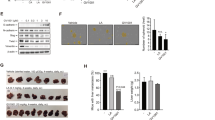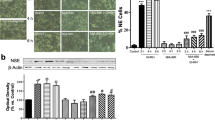Abstract
Goserelin acetate (Gos) is a synthetic analogue of luteinizing hormone-releasing hormone (LHRH) used in treatment of prostate cancer. The objective of this study is to investigate the in vitro cytotoxic effect of Goserelin loaded nanoparticles on both androgen dependent and androgen independent cell lines. Goserelin causes cell death of prostate cancer cell lines by inducing apoptosis. Treatment of Goserelin loaded nanoparticles inhibited the proliferation of LNCaP and DU145 in the dose-dependent manner, however did not affect the cell proliferation in PC-3 cell lines. Blank nanoparticles exhibited negligible cytotoxicity on cell lines. In addition, immunocytochemical studies indicated that Gos induced apoptosis in prostate cancer cells. The presence and characteristics of LHRH receptors and their messenger ribonucleic acid (mRNA) expression in human prostate cancer cell line LNCaP were investigated by polymerase chain reaction. Changes in nuclear morphology and DNA fragmentation associated with Gos induced apoptosis were clearly seen in both LNCaP and DU145 cell lines by DNA studies. The PCR product of the expected size of 319 bp for human LHRH receptors was obtained in cell line sample. Goserelin loaded nanoparticles are the potential tool for site specific delivery for prostate cancer treatment.








Similar content being viewed by others
References
Goethuys H, Baert L, Van Poppel H, Lieskovsky G, Brady LW, Petrovich Z. Treatment of metastatic carcinoma of the prostate. Am J Clin Oncol. 1997;20(1):40–5.
Denmeade SR, Isaacs JT. Development of prostate cancer treatment: the good news. Prostate. 2004;58:211–24.
Ruf F, Sealfon SC. Genomics view of gonadotrope signaling circuits. Trends Endocrinol Metab. 2004;15:331–8.
Conn PM, Crowley WF. Gonadotropin-releasing hormone and its analogs. Annu Rev Med. 1994;45:391–405.
Schally AV, Nagy A. New approaches to treatment of various cancers based on cytotoxic analogs of LHRH, somatostatin and bombesin. Life Sci. 2003;72:2305–20.
Neill JD, Musgrove LC, Duck LW. Newly recognized GnRH receptors: function and relative role. Trends Endocrinol Metab. 2004;15:383–92.
Cheng CK, Leung PC. Molecular biology of gonadotropin releasing hormone (GnRH)-I, GnRH-II and their receptors in humans. Endo Rev. 2005;26:283–306.
Miyamoto H, Messing EM, Chang C. Androgen deprivation therapy for prostate cancer: current status and future prospects. Prostate. 2004;61:332–53.
Kovacs M, Vincze B, Horvath JE, Seprodi J. Structure–activity study on the LH- and FSH releasing and anticancer effects of gonadotropinreleasing hormone (GnRH)-III analogs. Peptides. 2004;28(4):821–6.
Peternac D, Klima I, Cecchini MG, Studer UE, Thalmann GN. Prostate specific antigen expression does not necessarily correlate with prostate cancer cell growth. J Urol. 2006;176:354–60.
Limonta P, Dondi D, Moretti RM, Maggi R, Motta M. Antiproliferative effects of luteinizing hormone-releasing hormone agonists on the human prostatic cancer cell line LNCaP. J Clin Endocrinol Metab. 1992;75:207–12.
Tomar P, Jain N, Dixit VK. Nanoparticulate delivery of LHRH analogue for the treatment of prostate cancer. Pharm Dev Technol. 2012. Early online. doi: abs/10.3109/10837 450. 2012. 663389. http://www.ncbi.nlm.nih.gov/pubmed/22380019.
Szende B, Srkalovic G, Groot K, Schally AV. Regression of nitrosamine-induced pancreatic cancers in hamsters treated with luteinizing hormone-releasing hormone antagonists or agonists. Cancer Res. 1990;50:3716–21.
Thalmann GN, Sikes RA, Wu TT, Degeorges A, Chang SM, Ozen M. Lncap progression model of human prostate cancer: androgen-independence and osseous metastasis. Prostate. 2000;44:91–103.
Zheng D, Xiaolin L, Huae X, Xiaowei L, Yong H, Weixin F. Study on docetaxel-loaded nanoparticles with high antitumor efficacy against malignant melanoma. Act Biochim Biophys Sin. 2009;41(7):578–87.
Rutian L, Li X, Li X, Ding D, Hu Y, Qian X, et al. Preparation and evaluation of PEG–PCL nanoparticles for local tetradrine delivery. Int J Pharm. 2009;379:158–66.
Gryparis E, Hatziapostolou M, Evangeli P, Konstantinos A. Anticancer activity of cisplatin-loaded PLGA-mPEG nanoparticles on LNCaP prostate cancer cells. Euro J Pharm Biopharm. 2007;67:1–8.
Wei X, Gong CY, Gou M, Fua S, Guo Q, Shi S, et al. Biodegradable poly(caprolactone)–poly(ethylene glycol) copolymers as drug delivery system. Int J Pharm. 2009;381:1–18.
Dondi D, Moretti RM, Montagnani Marelli M, Pratesi G, Polizzi D, Milani M, et al. Growth-inhibitory effects of luteinizing hormone-releasing hormone (LHRH) agonists on xenografts of the DU 145 human androgen-independent prostate cancer cell line in nude mice. Int J Can. 1998;76:506–11.
Ravenna L, Salvatori L, Morrone S, Lubrano C, Cardillo MR, Sciarra F. Effects of triptorelin, a gonadotropin-releasing hormone agonist, on the human prostatic cell lines PC-3 and LNCaP. J Androl. 2000;21:549–57.
Collins JA, Schandl CA, Young KK, Vesely J, Willingham MC. Major DNA fragmentation is a late event in apoptosis. J Histochem Cytochem. 1997;45:923–34.
Liang P, Pardee AB. Differential display of eukaryotic messenger RNA by means of the polymerase chain reaction. Science. 1992;257:967–71.
Lau HL, Zhu XM, Leung PC, Chan LW, Chan PS. Detection of mRNA expression of gonadotropin-releasing hormone and its receptor in normal and neoplastic rat prostates. Int J Oncol. 2001;19:1193–201.
Darzynkiewicz Z, Bedner E, Traganos F, Murakami T. Critical aspects in the analysis of apoptosis and necrosis. Hum Cell. 1998;11:3–12.
Acknowledgement
The authors are thankful to Defence research and development, Gwalior, for providing the facility that allowed them to conduct and complete this research work.
Author information
Authors and Affiliations
Corresponding author
Rights and permissions
About this article
Cite this article
Tomar, P., Jain, N., Agarwal, G.S. et al. Goserelin loaded nanoparticles inhibit growth and induce apoptosis in human prostate cancer cell lines. Drug Deliv. and Transl. Res. 2, 265–271 (2012). https://doi.org/10.1007/s13346-012-0082-2
Published:
Issue Date:
DOI: https://doi.org/10.1007/s13346-012-0082-2




